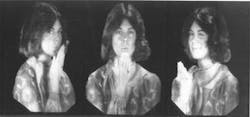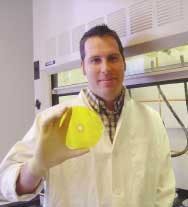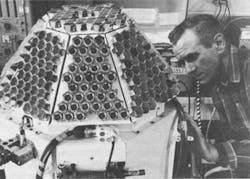Hollywood and holography: To be or not to be?
I still have that first hologram from my freshman physics lab-a dog figurine made of seashells that was exposed on a small glass plate with a HeNe laser in a pitch-black laboratory over several minutes as all the students tried to keep still, not daring to touch the vibration-isolation table. Even for a college student who understood (at the time) all the intricate scientific details involved in forming this three-dimensional (3-D) image, the process and the result was simply fascinating. With the invention of holography in 1947 by Dennis Gabor, and shortly after the invention of the laser in 1960, which made high-quality holograms possible, many of those first holography pioneers must have also assumed that the fascinating scientific technique of holography would someday find its way to the public-perhaps through animated 3-D phone messages or holographic motion pictures.
But while white-light reflection holograms are relatively common, true visual or animated holograms have not materialized for the masses. To make a hologram in the early days, the science demanded that the object stay very still, be comparable in size to the recording medium, and be of a highly reflective quality. In his article on direct-write digital holography, author David Pizzanelli says that Stephen Benton, inventor of the rainbow hologram, once remarked, “The disappointing reality for the general public when they go to buy a hologram is that they find them to be 3-D images of small dead things.”1
Sadly, one of the best animated holograms today is still the walk-by multiplex hologram titled “The Kiss II,” created in 1974 by Lloyd Cross (see Fig. 1).2 This integral hologram, or holographic stereogram, combined white-light transmission holography and conventional cinematography to produce a moving 3-D image. Sequential frames of 2-D motion-picture footage of a rotating subject are recorded on holographic film and the composite images are synthesized by the human brain as a 3-D image when viewed.
It may also be a disappointment to learn that the ghostly images in Disneyland’s Haunted Mansion, as well as the 3-D image of Princess Leia projected from R2-D2’s dome in the original Star Wars film, were not holograms, but merely optical trickery or cinematographic effect. The reasons why holography and Hollywood remain separate entities have much to do with the complexity of the holographic technique, and little to do with the public’s insatiable need for more spectacular video technologies.
Holographic movies
It turns out that creating a holographic movie is no small feat. The Sept. 1, 1965, issue of Laser Focus reports the showing of a holographic movie. “During a four-day government-sponsored Stanford Electronics Research Review Conference (Aug. 16-20), there was a showing of a hologram motion picture made on 35-mm film. According to Stanford, not only was this the first holographic motion picture ever produced, it was also the first demonstration that laser holograms could be made on a continuous strip of film.” In the following issue, Sept. 15, 1965, a report described the movies as having no plots and starring only some rolling steel balls and a wristwatch with moving hands-although it drew much interest. “The sophisticated viewers found the two shows more exciting than a Hollywood premiere.”
Unfortunately, the story ended on a pessimistic note. “Stanford scientists report that to film faster motion would be much more difficult-and the problems of holographic television are even more awesome.” Indeed, even in 2005, Gregory J. Salamo, professor of physics at the University of Arkansas (Fayetteville, AR), who worked with the Army Research Laboratory in Adelphi, MD, on activities related to multiplex holography, has reservations. “Some serious issues must be considered for practical application of holography to developing 3-D movies,” he says. “One important issue that must be overcome is the difficulty of making holograms of real people. This would mean that a coherent laser would have to strike the actors as the hologram was being made. This would require unreasonable laser systems and a good deal of care not to cause injury.” Salamo is optimistic, however. “Today it is possible to computerize the fabrication of holograms so that a more reasonable possibility would be to consider making animated holographic movies,” he says.
Beyond Hollywood . . .
Even though it may be decades before technologists figure out how to make true animated holographic imagery possible, the technique of holography continues to be used in thousands of practical ways. It has been used for applications in submicron photolithography through the creation of volume holograms in a waveguide (see Laser Focus World, October 2004, p. 73), for nondestructive testing of a variety of materials through digital holograms or interferograms (see Laser Focus World, May 2004, p. 137, and March 1998, p. 107), and for obvious entertainment value through holographic displays (see Laser Focus World, February 2003, p. 32).
Perhaps one of the most practical and promising applications of holography is for media storage. In October of 2002, Aprilis (Maynard, MA) unveiled what it called the “first viable holographic storage media.” The holographic disc boasted a data density of greater than 100 Gbit/in.2 and used a 532-nm frequency-doubled Nd:YAG laser for recording (see Laser Focus World, February 2003, p. 17). In February of 2004, InPhase Technologies (Longmont, CO) shipped the first blue laser holographic media, the Tapestry HDS5000. Compatible with next-generation blue lasers used in DVDs, the Tapestry media will eventually be used in holographic recorders and players that will have terabytes of capacity on a single disc (see Fig. 2). And Optware (Kanagawa, Japan), a developer of holographic media storage systems, is one of six Japanese companies that recently formed the Holographic Versatile Disc (HVD) Alliance to accelerate the development of HVD in the marketplace.
In January 2005 Ecma International (Geneva, Switzerland), an industry association founded in 1961 and dedicated to the standardization of information and communication technology and consumer electronics, announced a move toward a standard for holographic information storage (HIS). Ecma created Technical Committe 44 (TC44) to develop a standardization strategy for HIS systems, initially based upon the collinear technologies of Optware. This committee was set up at the request of Optware and several of its partners, including CMC Magnetics, Fuji Photo Film, and Pulstec Industrial.
While holographic media storage clearly has a promising future, it will be some time before we hear, “Holographic movies now playing at a theater near you.”
REFERENCES
1. D. Pizzanelli, Stereoscopic SocietyJ. 3-D Imaging152, 19 (April 2001).
2. P. D. Barefoot, “History of Holography,” Holophile (Killingworth, CT); www.holophile.com.
Inside Laser Focus: June 1965
- Laser Biobeams-How good are they?
- Biomedical Applications-A special report
- More on multichannel TV relay via laser
- Explorer XXVII continues laser experiments
- Laser measures extra-high-voltage line current
- Laser or optical maser-A rose by any other name . . .
- Status report on a biomedical laser laboratory
- Cancer-destroying ability of laser found predictable
- British-evolved narrow-band gas laser operates CW in far-infrared region
- Laser tracking systems described by military, civilian agencies
- Year-old English lab reports in progress
- Laser interferometer/Digital counter measures small displacements
- Organic and chelate laser materials-the state of the art
- Doube-doped crystal lases at room temperature
- Host material is dominant pumping mechanism for new laser crystal
null



